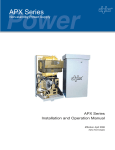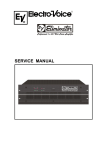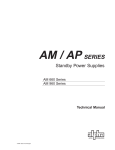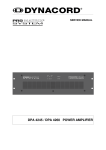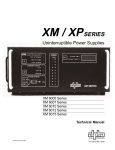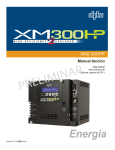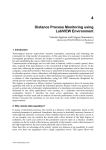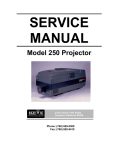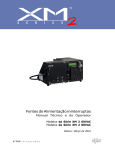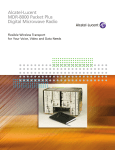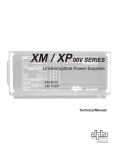Download Alpha Technologies APX Series Operator`s manual
Transcript
Operator's Manual APC Series APL Series NON-STANDBY FROM ©1996 Alpha Technologies ALPHA POWER SUPPLIES TECHNOLOGIES APC AND APL SERIES NON-STANDBY POWER SUPPLIES IMPORTANT SAFETY INSTRUCTIONS CONTAINED IN THIS MANUAL CAUTION RISK OF ELECTRICAL SHOCK CAUTION: TO REDUCE THE RISK OF ELECTRICAL SHOCK, AND ENSURE THE SAFE OPERATION OF THIS UNIT, THE FOLLOWING SYMBOLS HAVE BEEN PLACED THROUGHOUT THE MANUAL. WHERE THESE SYMBOLS APPEAR, SERVICING SHOULD BE PERFORMED ONLY BY QUALIFIED PERSONNEL. DANGEROUS VOLTAGE A DANGEROUS VOLTAGE EXISTS IN THIS AREA. USE EXTREME CAUTION. ATTENTION IMPORTANT OPERATING INSTRUCTIONS. FOLLOW THESE INSTRUCTIONS CLOSELY. SAVE THESE INSTRUCTIONS i APC SERIES NON-STANDBY POWER SUPPLIES ii APC SERIES NON-STANDBY POWER SUPPLIES Table of Contents 1. 1.1 INTRODUCTION The APC (APL) Non-Standby Power Supply 1 1.2 Operating Principle 2 1.3 1.3.1 1.3.2 1.3.3 1.3.4 1.3.5 1.3.6 1.3.7 Standard Features APC (APL) 6008 APC (APL) 6014 APC (APL) 6008 E APC (APL) 6014 E APC 4808 E APC 6008 P APC 6014 P 3 3 3 3 3 3 3 3 1.4 1.4.1 1.4.2 1.4.3 1.4.4 1.4.5 1.4.6 Optional Features SIL-C LA-M AMM-C TDR-M ACAT-3P GLK 5 5 5 5 5 5 6 2. 2.1 2.2 2.2.1 2.2.2 2.3 2.4 2.5 2.6 INSTALLATION Unpacking and Inspection Pole-mount Installations Wooden Poles Concrete and Steel Poles Wall-mount Installations Pedestal-mount Installations Rack-mount Installations Shelf-mount Installations 7 7 8 8 10 11 12 15 17 2.7 2.7.1 Connecting Utility Power Wiring the Enclosure’s Utility Service 120VAC-60Hz 230VAC-50Hz External Service Disconnect Modular Transformer Assembly Pole-mount, Wall-mount, Universal-bracket Pedestal-mount AC Output Connection 19 2.7.1.1 2.7.1.2 2.8 2.9 2.9.1 2.9.2 2.10 2.11 2.11.1 2.11.2 2.11.2.1 2.11.2.2 2.11.3 2.11.4 Options SIL-C (Status Indicator Led) LA-M (Lightning Arrestor) LA-L LA-E AMM-C (Ammeter) TDR-M (Time Delay Relay) ACAT-3P (Plug-in Amp Clamp) 2.11.5 Rack-mount Options 2.11.5.1 ACAT-3P and TDR-M 2.11.5.2 LA-P 2.11.5.3 LA-E iii 1 19 19 20 21 23 23 23 25 26 26 27 27 27 29 31 31 32 32 32 33 APC SERIES NON-STANDBY POWER SUPPLIES Table of Contents 3.0 3.1 3.2 OPERATION Start-up and Testing APC Shutdown and MTA Removal 34 34 35 4.0 4.1 4.1.1 4.1.2 4.1.3 4.1.4 4.1.5 TROUBLESHOOTING Troubleshooting and Repair Troubleshooting Guide Repair Instructions Parts and Ordering Information Replacement Parts Schematic / Block Diagram 36 36 36 37 37 37 38 5.0 SPECIFICATIONS 39 6.0 WARRANTY 40 iv 1. INTRODUCTION 1.1 The APC (APL) Non-Standby Power Supply Product Description: Alpha APC (APL) Series non-standby power supplies provide conditioned power to signal amplifiers in Cable Television and Broadband distribution systems. The modular design, which consists of a baseplate, transformer assembly and enclosure cover, supplies the load with current-limited, regulated AC power that is free from disturbances caused by spikes, surges and other forms of power line transients. AC power enters the module where it is converted to a “quasi” square wave and regulated (at the required output voltage). It is then passed on to the load via the VSF fitting located on the baseplate assembly. The modular design of the APC and APL Series of non-standby power supplies allow for easy upgrades (or downgrades) depending on the particular power application simply by replacing the transformer assembly, thus saving time and money. The versatile APC (APL) Series non-standby power supply is designed to be polemounted (wooden or concrete), wall mounted, rack mounted, shelf mounted, or pedestal mounted. Operator controls are located inside the enclosure on the main transformer assembly. The APC (APL) includes an AC input circuit breaker, output fuse, *output receptacle, VSF fitting, and external grounding clamp. The APC (APL) can also be equipped with various options including: a *Time Delay Relay (TDR-M) to suspend power to the output from 10-60 seconds during utility start-up after an AC outage has occurred; a Plug-in Lightning Arrestor (LA-M) to provide additional protection from voltages spikes caused by lightning or other power line disturbances; a Status Indicator LED (SIL-C) to indicate acceptable output power is being supplied to the load; a plug-in *Amp-Clamp (ACAT-3P) to provide “Crowbar” clamping protection from voltage spikes in excess of 104 volts; an *Ammeter (AMM-C) to display output current to the load; and an Enclosure Security Lock (GLK) for additional security in accessible areas. The APL is a low cost, compact version of the APC non-standby power supply and features all of the transient and spike protection found in the APC. Options include; SIL-C; LA-L; and GLK, described above. The APC (APL) series, along with the entire line of Alpha power products, are designed to be one of the most rugged, reliable, and versatile power supplies available. Alpha Technologies, recognized as an international market leader in the field of backup power, offers complete technical support and prompt, reliable service to ensure that your power supplies continue to provide you with years of trouble-free operation. * These options are not available for APL Series non-standby power supplies. 1 1. INTRODUCTION 1.2 Operating Principle The Modular Transformer Assembly (MTA) contains a ferroresonant transformer, resonant circuit capacitor, and control panel with line input circuit breaker and output fuse assembly. Alpha APC (APL) Series non-standby power supplies utilize ferroresonant transformer technology to provide line conditioning and voltage regulation. The primary and secondary windings of the transformer are physically isolated from each other by a large steel core which significantly reduces the capacitive coupling of spikes and noise to the secondary winding. This provides a regulated, currentlimited output with excellent isolation and noise attenuation: 120dB common mode; 60dB transverse mode. An oil-filled resonant AC capacitor is connected to the resonant (secondary) winding of the transformer forming a tank circuit. This provides the resonant circuit function which contributes to the voltage regulation of the supply. The advantage of this type of transformer / capacitor design is the ability of the ferroresonant transformer to regulate its output voltage over a wide range of input voltages and output loading. Typical output voltages may vary + 3 to 5%, with input voltages variations of + 15% of nominal line voltage, and output loading of 20 to 100%. This tight regulation is advantageous in cable television applications as the active devices are protected from dangerous voltages fluctuations. Another unique feature of the ferroresonant transformer is its ability to provide current limiting in the event of a short-circuit. This effect is called foldback. The transformer’s output current can typically reach 150% of the nameplate output current rating for a short period of time without damage to the transformer. When the transformer reaches the saturation point, the output current will decrease (foldback on itself) to a minimum value, and thereby provide current limiting. Designs based on ferroresonant transformer are extremely rugged and reliable offering many years of trouble-free operation. Alpha’s non-standby power supplies are extremely efficient, having a typical efficiency rating of 90% or better. The output waveform from the ferroresonant transformer is not a true sine or square wave, but is instead a quasi-square wave. NOTE: A true RMS voltmeter must be used to correctly measure the output voltages. T1 Ferroresonant transformer and AC capacitor Noisy input waveform C1 Clean output waveform Ferroresonant ‘Tank’ circuit and resulting output waveform 2 1. INTRODUCTION 1.3 Standard Features The APC (APL) Series non-standby power supplies are available in the following configurations: 1.3.1 APC (APL) 6008 Non-Standby Power Supply (120 VAC, 60 Hz Input) (8 Amp, 480 VA, 60 Volt Output); available in Pole, Rack, Wall, Shelf, or Pedestal-mount configurations. Includes: 8 Amp thermal input circuit breaker, 120 VAC output receptacle and 10 Amp output fuse. 1.3.2 APC (APL) 6014 Non-Standby Power Supply (120 VAC, 60 Hz Input) (14 Amp, 840 VA, 60 Volt Output); available in Pole, Rack, Wall, Shelf, or Pedestal-mount configurations. Includes: 12 Amp thermal input circuit breaker, 120 VAC output receptacle and 15 Amp output fuse. 1.3.3 APC (APL) 6008 E Non-Standby Power Supply (230 VAC, 50 Hz Input) (8 Amp, 480 VA, 60 or 48 Volt Output); available in Pole, Rack, Wall, Shelf, or Pedestal-mount configurations. Includes: 8 Amp thermal input circuit breaker, 230 VAC output receptacle and 10 Amp output fuse. 1.3.4 APC (APL) 6014 E Non-Standby Power Supply (230 VAC, 50 Hz Input) (14 Amp, 840 VA, 60 or 48 Volt Output); available in Pole, Rack, Wall, Shelf, or Pedestal-mount configurations. Includes: 12 Amp thermal input circuit breaker, 230 VAC output receptacle and 15 Amp output fuse. 1.3.5 APC 4808 E Non-Standby Power Supply (230 VAC, 50 Hz Input) (8 Amp, 384 VA, 48 Volt Output); available in Pole, Rack, Wall, Shelf, or Pedestal-mount configurations. Includes: 8 Amp thermal input circuit breaker, 230 VAC output receptacle and 10 Amp output fuse. 1.3.6 APC 6008 P Non-Standby Power Supply (220 VAC, 60 Hz Input) (8 Amp, 480 VA, 60 Volt Output); available in Pole, Rack, Wall, Shelf, or Pedestal-mount configurations. Includes: 8 Amp thermal input circuit breaker, 120 VAC output receptacle and 10 Amp output fuse. 1.3.7 APC 6014 P Non-Standby Power Supply (220 VAC, 60 Hz Input) (14 Amp, 840 VA, 60 Volt Output); available in Pole, Rack, Wall, Shelf, or Pedestal-mount configurations. Includes: 12 Amp thermal input circuit breaker, 120 VAC output receptacle and 15 Amp output fuse. 3 1. INTRODUCTION 1.3 Standard Features, continued Main Transformer Assembly (MTA) Enclosure Cover Baseplate Assembly Pad-Lock Holes Photo 1.3.a Pole Mount Enclosure Photo 1.3.b APC Main Transformer Assembly Photo 1.3.c APL Main Transformer Assembly 4 1. INTRODUCTION 1.4 Optional Features APC (APL) Series non-standby power supplies can also be equipped with the following options: 1.4.1 SIL-C (Status Indicator LED) The Status Indicator LED (red) indicates that the APC (APL) is supplying AC output to the load. The long-life LED pilot lamp can be viewed from outside the enclosure. As long as power is present at the modules output, the lamp remains ON. This acts as a simple form of status monitoring by allowing the technician to check the status of the power supply’s output without having to open the enclosure. 1.4.2 LA-M (Plug-in Lightning Arrestor) The LA-M consists of a 350 joule, Metal Oxide Varistor (MOV) for primary site protection. The LA-M, which is enclosed in a plastic housing, plugs directly into a dedicated receptacle eliminating the need for additional wiring. This option provides additional protection from voltage spikes caused by lightning and other power disturbances. The LA-L (120VAC) and LA-L E (230VAC) option, which must be hard-wired onto the input block, is available for the APL Series of non-standby power supplies. NOTE: The LA-E is available for 230 VAC applications. This model is housed in an aluminum enclosure and must be hard wired into the APC. 1.4.3 *AMM-C (Ammeter) The AMM-C Ammeter displays the output current to the load. It is also useful as a status indicator: A zero reading would indicate that no output current is being drawn by the load, a pegged meter would indicate a short circuit condition in the plant. 1.4.4 *TDR-M (Plug-in Time Delay Relay) When the AC utility line voltage returns after a power outage, the AC line voltage may not stabilize for several seconds, and could contain noise spikes and other transients. The TDR-M delays power to the output from 10 to 60 seconds, thereby reducing these transients associated with the start-up of utility power after an outage has occurred. 1.4.5 *ACAT-3P (Plug-in Amp Clamp) The ACAT-3P Amp Clamp is designed to protect active and passive equipment from voltage surges and transients. The plug-in Amp Clamp consists of two rugged SCR’s (silicon controlled rectifiers) connected in an inverse parallel configuration with a steady state current of 35 Amps and a one cycle (8 ms) pulse rating of 500 Amps. The SCR’s are triggered into conduction whenever the Amp Clamp’s bidirectional trigger diodes senses the presence of voltage transients exceeding 104-115 Volt peak threshold. The fast response trigger circuit gates the appropriate SCR ON (in nanoseconds) to shunt the surge current to ground, effectively protecting sensitive equipment from transient overvoltage conditions. * These options are not available for the APL Series of non-standby power supplies. 5 1. INTRODUCTION 1.4 Optional Features, continued 1.4.6 GLK (Enclosure Locks) APC (APL) Pole Mount enclosures can be equipped with an optional security lock in situations where accessibility or tampering may be a problem. PM models come equipped with a security hole for installing a standard padlock (see figure 1.3.a). Modular Transformer Assembly (MTA) Enclosure Cover GLK Baseplate Assembly SIL-C LA-M ACAT-3P AMM-C TDR-M The Alpha APC (PM) and Installable Options 6 2. INSTALLATION 2.1 Unpacking and Inspection To ensure operator safety: 1. Power supplies should be installed only by qualified personnel and always in accordance with applicable electrical codes. 2. Use a bucket truck or suitable climbing equipment, such as safety harness and spikes, whenever installing pole-mount installations. 2.1 Unpacking and Inspection Carefully remove the APC from its shipping container. Make sure that the following items have been included: 1. 2. 3. *APC (APL) Series Non-Standby Power Supply Operator’s Manual Any ordered options Inspect the contents. If items are damaged or missing, contact Alpha Technologies and the shipping company immediately. Most shipping companies have only a short claim period. SAVE THE ORIGINAL SHIPPING CONTAINER. In the event a unit needs to be returned for service, it should be packaged in its original shipping container. If the original container is not available, make sure the unit is packed with at least three inches of shock absorbing material to prevent shipping damage. NOTE: DO not use popcorn-type material. Alpha Technologies is not responsible for damage caused by improper packing on returned units. READ THE OPERATOR’S MANUAL. Become familiar with the operation of the power supply. Review the drawings and illustrations contained in the manual before proceeding. If you have questions regarding the safe operation of this unit, contact Alpha Technologies or your nearest Alpha representative. *The items supplied may vary according to the model type as follows: Pole-mount - (Baseplate Assembly, Modular Transformer Assembly (MTA), Enclosure Cover). Pedestal-mount - (PED Enclosure, Universal Bracket 1 (UB1), Modular Transformer Assembly). Shelf-mount - (Shelf-mount Bracket, Extension Power Cable, Modular Transformer Assembly). Wall-mount - (Wall-mount Bracket (WM), Baseplate Assembly, Modular Transformer Assembly (MTA), Enclosure Cover). 7 2. INSTALLATION 2.2 Pole-mount Installations The APC- PM and APL-PM are designed to be mounted on wooden, steel, or concrete poles. When used with wooden poles, mounting bolts that go completely through the pole should be used. When used with concrete poles, an approved mounting strap should be used. Most codes require the base of the enclosure to be located at a minimum height from the ground. Always verify height restrictions before proceeding. NOTE: THE MAJORITY OF POLES ARE THE PROPERTY OF THE LOCAL UTILITY. BEFORE INSTALLING AN ENCLOSURE, THE LOCATION AND THE METHOD OF MOUNTING MUST BE APPROVED BY THE UTILITY. NOTE: BEFORE INSTALLING THE MTA, ENSURE THAT ALL OPTIONS HAVE BEEN INSTALLED AND PROPERLY CONNECTED. 2.2.1 Wooden Poles Materials Required: Two (2) 5/8” diameter machine bolts (UNC thread) SAE Grade 5 or better, length to suit pole; Four (4) 5/8” diameter zinc-plated flat washers; Two (2) 5/8” diameter hex nuts (UNC thread). Tools Required: Auger or drill for boring 3/4” diameter holes through the wooden pole. Associated sockets or wrenches. Procedure: 1. Un-box the APC or APL and set the unit on its back (mounting bracket down). 2. Loosen the enclosure’s front panel hold-down screw and tilt the cover forward. Remove the cover by sliding (at the hinges) to the right. 3. Loosen the captive screw at the bottom of the units baseplate. Lift the Modular transformer assembly up and off of the enclosure’s baseplate. Set the MTA aside. 4. Mark the position for the upper mounting bolt on the utility pole. Drill a 3/4” hole completely through the pole. 5. Use the baseplate as a template. Align the upper hole in the baseplate with the upper hole in the utility pole (from step 4). The spacing between the marks should be 4.5” c-c. Drill the lower mounting hole. 6. Place a flat washer on each bolt and insert the mounting bolts through the baseplate assembly and pole. 7. Secure both bolts using a 5/8” washer and nut. Tighten the nuts until the flanges on the baseplate’s mounting bracket dig into the wood approximately 1/4”. 8. Install the Modular Transformer Assembly (MTA) onto the baseplate, (see section 2.9 MODULAR TRANSFORMER ASSEMBLY). 8 2. INSTALLATION 2.2 Pole-mount Installations, continued Service Drop Enclosure Mounting Bracket 5/8” Diameter Bolts and Associated Hardware APC (APL) Enclosure NOTE: If mounting to a steel or concrete pole, use these two strap slots 4.5” center-center Utility Power Input (from Service Entrance) VSF Output Connector 60 VAC Cable Output #8 AWG (Minimum) Copper Ground Wire To Service Entrance Illustration 2.2 APC (APL) Enclosure Pole Mounting 9 2. INSTALLATION 2.2 Pole-mount Installations, continued 2.2.2 Concrete and Steel Poles Materials Required: Two (2) 1-1/2” mounting straps, length to suit pole. Tools Required: Assorted sockets or wrenches. Procedure: 1. Mark the position for the upper mounting strap on the utility pole. 2. Run two, approved 1-1/2” mounting straps through the mounting bracket located on the back of the baseplate assembly. 3. Center the baseplate assembly on the pole and tighten the mounting straps. 4. Install the Modular Transformer Assembly (MTA) onto the baseplate, (see section 2.9 MODULAR TRANSFORMER ASSEMBLY). 10 2. INSTALLATION 2.3 Wall-mount Installations The wall-mount version is equipped with an adaptor bracket allowing the APC or APL pole-mount enclosure to be mounted on a flat, vertical surface. NOTE: BEFORE INSTALLING THE MTA, ENSURE THAT ALL OPTIONS HAVE BEEN INSTALLED AND PROPERLY CONNECTED. REFER TO SECTION 2.11 OPTIONS, FOR INSTALLATION PROCEDURES. Procedure: 1. Mount the wall-mount bracket to a flat vertical surface. The mounting area should be located directly in front of a wall stud (2 x 4; 2 x 6; etc.). If such an area is not possible, appropriate anchors and lag bolts must be used. Mount the bracket by first marking the location for the holes, using the bracket as a template (the distance between the holes is 4.5” c-c). 2. Drill out the holes using a 1/4” drill bit. Mount the bracket to the wall using two (2) 3/8” x 1.5” long steel lag bolts and washers. Make certain that the 1/4-20 (Phillips) screw is located in the upper right-hand side of the bracket before securing it to the wall. 3. Mount the enclosure to the wall bracket by fitting the slots (in the APC or APL enclosure bracket) over the rivets in the wall bracket. The enclosure’s bracket fits on the outside of the wall bracket. Tighten the screw located on the upper-right corner of the wall bracket using a #2 Phillips head screwdriver. 4. Install the Modular Transformer Assembly (MTA) onto the baseplate, (see section 2.9 MODULAR TRANSFORMER ASSEMBLY). 1/4-20 Screw (upper-right hand side) Photo 2.3.a Wall Mount Bracket Wall Mounting Holes Photo 2.3.b Photo 2.3.c Align Slots with rivets and Screw Tighten Screw 11 2. INSTALLATION 2.4 Pedestal-mount Installations The pedestal-mount (PED) is constructed of weather-resistant steel and is ideal for ground mount applications. The PED model is supplied with a stake for soilmounting applications, an optional concrete mounting kit may be ordered for mounting to a concrete pad. NOTE: BEFORE INSTALLING THE MTA, ENSURE THAT ALL OPTIONS HAVE BEEN INSTALLED AND PROPERLY CONNECTED. WARNING: THE PED ENCLOSURE MUST BE INSTALLED ABOVE THE FLOOD PLANE AND LOCATED IN AN AREA WHERE IT WILL NOT RECEIVE DAMAGE FROM TRAFFIC ACCIDENTS, LAWN CARE EQUIPMENT, ETC. Procedure: (soil-mount version) Before proceeding, loosen the hex screw located on the right side of the enclosure. Lift off the hood and remove the MTA (if installed), and Universal Bracket (UB1) from the PED. The UB1 is secured by a wing-nut located near the top of the PED. 1. Locate the area where the PED is to be installed. There should be a slight depression where the PED will be placed; 6” deep x 14” wide. This will allow room to work while the PED is being installed and also provide additional security and stability to the installation. NOTE: When sinking the stake into the soil be extremely careful not to damage any underground cabling, utility wires, water or gas pipes. If you are uncertain of these locations, contact the local utilities for a survey. 2. 3. 4. 5. Drive the mounting stake into the soil at the location the PED is to be installed. Leave about 6” of the stake above the soil depression. NOTE: Ensure that the stake is completely vertical and not driven-in at an angle. Place the PED over the utility and cable feeds. Align two of the holes in the back of the enclosure with two holes in the stake. Secure the enclosure to the stake using the two (2) bolts, washers and nuts. Mound the soil around the outside of the enclosure to bring it level with the surrounding area. For additional stability, soil can be added inside of the enclosure to bring it level with the outside soil line. Reinstall the UB1 Bracket and place the MTA onto this bracket. Tighten the captive on the bottom of the UB1 to secure the MTA, (see section 2.9 MODULAR TRANSFORMER ASSEMBLY and 2.7 CONNECTING UTILITY POWER). NOTE: A more secure method for mounting the enclosure would be to drive-in the stake and mount the enclosure level with the surrounding soil (no depression), place a wooden form around the outside of the enclosure and pour concrete to a depth of 3 or 4 inches. PED Enclosure Hood Wing-nut PED-Universal Bracket (UB1) Mounting Stake PED Enclosure Base Unit Photo 2.4.a 12 2. INSTALLATION 2.4 Pedestal-mount Installations, continued Poured Concrete Detail showing mounting stake and hardware Photo 2.4.a Stake Mounting Cable Utility Mounting Stake Photo 2.4.b Poured Concrete Illustration 2.4 Concrete Pad Mounting 13 2. INSTALLATION 2.4 Pedestal-mount Installations, continued Procedure: (concrete-mount version) Illustration 2.4; Photos 2.4.c, .d The PED enclosure can be mounted to a concrete pad using the optional mounting bracket. The bracket is mounted inside the rear of the enclosure using two (2) hex bolts and washers. Two (2) 0.5” oblong mounting holes are provided in the bracket to mount the enclosure to the concrete pad. Two (2) 3/8” J-bolts must be placed in the pad as specified and two conduits (utility and cable output) should be placed centered in front of these bolts. If required, an 8’ dedicated ground rod should be placed near the utility conduit. To mount the enclosure to the pad, use a 3/8” lock washer and nut on each mounting bolt. NOTE: The enclosure must be mounted on a flush smooth surface and not overtorqued to prevent damage. Alpha Technologies is not responsible for damages incurred to the enclosure by improper mounting on uneven surfaces. Before proceeding, remove the MTA (if installed) and universal bracket (UB1) from the PED. 1. Install the concrete mounting bracket on the enclosure using the included bolts, washers and nuts. Insert the bolts from the outside of the enclosure. 2. Center the enclosure over the utility and cable conduits. Align the oblong holes in the mounting bracket with the 3/8” J-bolts. Secure the enclosure with a lock washer and nut. 3. Reinstall the UB1 Bracket and place the MTA onto this bracket. Tighten the captive on the bottom of the UB1 to secure the MTA, (see section 2.9 MODULAR TRANSFORMER ASSEMBLY and 2.7 CONNECTING UTILITY POWER). Pad Mounting Slots PED Mounting Holes Photo 2.4.c Concrete Mount and Hardware Photo 2.4.d Concrete Mounting Bracket Detail 14 2. INSTALLATION 2.5 Rack-mount Installations The APC is also available in a rack-mount version that can be installed into a standard 19” rack. The APL is not available in a rack-mount model. NOTE: BEFORE INSTALLING THE APC, ENSURE THAT ALL OPTIONS HAVE BEEN INSTALLED AND PROPERLY CONNECTED. REFER TO SECTION 2.11 OPTIONS, FOR INSTALLATION INSTRUCTIONS. Procedure: Photo 2.5.a 1. To mount the APC into a standard 19” rack, use 10-32 screws and cup washers (not supplied by Alpha) to secure the APC to the rack rails. Leave 1” clearance above and below the 7” panel height for clearance and cooling when other equipment is installed in the rack. If other APC power supplies are installed in the same rack, they may be stacked without clearance between them, but leave sufficient clearance between the top and bottom supplies in the stack, and adjacent equipment or walls. If an enclosed rack or cabinet is used, leave at least 2” clearance between the transformer and surrounding wall panels, and provide ventilation through the use of louvered rear panels (or leave open if permissible). 2. The APC is supplied with an additional 3’ (1.0m) power cord. This cord connects between the short cord on the rack-mount APC and a standard receptacle box. 3. The APC is now ready for the operation (see section 3.1 START-UP AND TEST). Rack mounting slots Ammeter TDR-M adjustment access hole Push-push circuit breaker SIL-C LA-P Receptacle Fuse Photo 2.5.a APC Rack-mount (120 VAC Version) 15 2. INSTALLATION 2.5 Rack-mount Installations, continued TDR-M LA-P receptacle ACAT-3P 3-pin connector Output connector (60 VAC) 2-pin connector Power input cord Shorting connector Photo 2.5.b Option placement and power connections Photo 2.5.c APC-E Rack-mount (230 VAC Version) 16 2. INSTALLATION 2.6 Shelf-mount Installations The shelf-mount version of the APC (APL) consists of the standard MTA (Modular Transformer Assembly) which rests on a mounting plate (SM). The mounting plate and MTA can then be installed into an enclosure such as the PED- M, PWE or UPE. The shelf-mount option also includes an input AC power extension cable (APC model only) and an APC - SPI adaptor. NOTE: BEFORE INSTALLING THE APC, ENSURE THAT ALL OPTIONS HAVE BEEN INSTALLED AND PROPERLY CONNECTED. REFER TO SECTION 2.11 OPTIONS, FOR INSTALLATION INSTRUCTIONS. Procedure: Photos 2.6.a, .b, .c 1. Place the modular transformer assembly (MTA) onto the shelf-mount (SM) by fitting the slot on the top of the MTA over the tab on the SM bracket. 2. Locate the captive screw on the opposite side of the shelf-mount adaptor (next to the terminal block). Fit this captive screw into the threaded portion of the MTA and tighten. 3. Place the assembled shelf-mount bracket and modular transformer assembly into the shelf of the enclosure (PED-M, PWE or UPE). Place one of the key-slot holes over the threaded screw hole in the enclosure’s shelf. Install a 8-32 x 1/2” long screw and tighten. NOTE: Only one of the screw holes is used to mount the SM onto the enclosures shelf. To install additional APC-SM’s into the enclosure, you will need to drill and tap another mounting hole. 4. Connect the AC input power extension cable to the AC power cable on the unit. Connect the plug of the extension cable into the enclosures AC receptacle. NOTE: The APL model is connected to the utility power via the terminal block on the MTA 5. 6. Output connection to the plant is accomplished via the terminal block or by using SPI the APC - SPI adaptor cable. The APC (APL) is now ready for the utility connection (see section 3.1 START-UP AND TEST). Power Extension Cable APC Output Connection Block SPI Adaptor Cable Shelf Mount Captive Screw Photo 2.6.a Shelf Mount (SM) 17 2. INSTALLATION 2.6 Shelf-mount Installations, continued Hold-down screw APC Output to Terminal Block Photo 2.6.b PED-M, PWE or UPE Enclosure Mounting (using Terminal Block Output) APC Output to SPI (via SPI adaptor cable) Hold-down screw Photo 2.6.c PED-M, PWE or UPE Enclosure Mounting (using SPI Output) 18 2. INSTALLATION 2.7 Connecting Utility Power CAUTION: THE FOLLOWING SHOULD BE PERFORMED ONLY BY QUALIFIED SERVICE PERSONNEL AND IN COMPLIANCE WITH LOCAL ELECTRICAL CODES. CONNECTION TO UTILITY POWER MUST BE APPROVED BY THE LOCAL UTILITY BEFORE INSTALLING THE POWER SUPPLY. NOTE: UL AND NEC REQUIRE THAT A SERVICE DISCONNECT SWITCH (UL LISTED) BE PROVIDED BY THE INSTALLER AND BE CONNECTED BETWEEN THE POWER SOURCE AND THE ALPHA POWER SUPPLY. 2.7.1 Wiring the Enclosure’s Utility Service: Photos 2.7.1.a, .b The following does not apply to the rack-mount model (RM) or the shelf-mount model (SM) which plug into a receptacle in the rack or enclosure. The APL model is connected to the utility power via the APL’s terminal block (Photo 2.7.1.b). Utility power enters the enclosure through a 0.875” diameter opening at the bottom of the APC enclosure (Photo 2.7.1.c). The enclosure accepts a standard conduit fitting. When used in conjunction with the PED-M metered, ground-mount enclosure, utility power enters through a dedicated raceway. 60 VAC output VSF connector GROUND wire Ground lug for grounding rod NEUTRAL wire HOT wire Utility input SIL-C option Photo 2.7.1.a APC Bottom View Photo 2.7.1.b APL Wiring NOTE: BEFORE PROCEEDING, VERIFY THAT THE UTILITY POWER IS NOT ENERGIZED! DO NOT PLUG THE APC INTO THE AC RECEPTACLE AT THIS TIME. 2.7.1.1 Procedure: (120VAC, 60 HZ) Photo 2.7.1.1 If the Modular Transformer Assembly (MTA) is installed it must be completely removed during utility wiring. To remove the transformer assembly, loosen the captive screw on the bottom of the baseplate and remove the transformer assembly. 1. 2. 3. 4. Loosen the two captive screws securing the receptacle box. Turn the receptacle box over to expose the internal wiring. Route the utility conduit through the 0.875” diameter opening located at the bottom of the APC. Secure the fitting with a locknut. Connect the utility BLACK-HOT wire (120 VAC; 60 Hz) to the BLACK wire inside the receptacle box using the existing wire nut. Connect the WHITE-NEUTRAL wire to the WHITE wire inside the receptacle box using the existing wire nut. 19 2. INSTALLATION 2.7 Connecting Utility Power, continued 5. 6. 7. Connect the utility GREEN with YELLOW tracer GROUND wire to the grounding-wire-clamp on the baseplate and tighten the clamping screw. An external grounding clamp is also provided on the outside of the enclosure for connection to a ground-rod. Reposition the rear tab on the receptacle box into the slot in the baseplate. Tighten the two (2) captive screws. Reinstall the MTA and tighten the screw. LA-M Receptacle MTA Power Receptacle HOT wire (Black 120VAC/60 Hz) Neutral wire (White 120VAC/60 Hz) Grounding wire (Green) Grounding lug (Internal) Photo 2.7.1.1 120VAC/60Hz Wiring 120 VAC Utility Input 2.7.1.2 Procedure: (230 VAC, 50 HZ) Photo 2.7.1.2 If the modular transformer assembly is installed it must be completely removed during utility wiring. To remove the transformer assembly, loosen the captive screw on the bottom of the baseplate and remove the transformer assembly. 1. 2. 3. 4. 5. 6. 7. Loosen the two captive screws securing the receptacle box. Turn the receptacle box over to expose the internal wiring. Route the utility conduit through the 0.875” diameter opening at the bottom of the APC PM Enclosure. Secure the fitting with a lock nut. Connect the utility BROWN-HOT wire (230 VAC; 50 Hz) to the BROWN wire inside the receptacle box using the existing wire nut. Connect the BLUE-NEUTRAL wire to the BLUE wire inside the receptacle box using the existing wire nut. Connect the utility GREEN/YELLOW tracer -GROUND wire to the grounding wire clamp on the baseplate. Tighten the clamping screw. An external grounding clamp is also provided on the outside of the enclosure for connection to a ground-rod. Reposition the rear tab on the receptacle box into the slot in the baseplate. Tighten the two (2) captive screws. Reinstall the MTA and tighten the screw. MTA Power Receptacle LA-E Neutral wire (Blue 230VAC/50 Hz) HOT wire (Brown 230VAC/50 Hz) Grounding wire (Green/ yellow tracer) Photo 2.7.1.2 APC 230 VAC/50 Hz Wiring 20 2. INSTALLATION 2.8 External Service Disconnect The external service disconnect should be placed between the utility power connection and the APC non-standby power supply. For pole-mount enclosures, it should be attached directly to the utility pole using 1/4” x 2-1/4” steel wood screws. If a utility power meter is to be used, its mounting base should be secured in the same manner. Use a suitable conduit to interconnect the meter base, service disconnect and power supply enclosure. IMPORTANT NOTE: A high-magnetic 15 Amp circuit breaker should be used in order to accommodate the high inrush currents normally associated with start-up of ferroresonant transformers (400 Amp, no-trip, first half cycle). Conventional service entrance breakers are not recommended. High-magnetic breakers for Square D service entrances enclosures are available from Alpha Technologies. Device Circuit Breaker Alpha BBX Option Alpha Part No. 470-013-10 020-085-10 Square D Q0115HM Q02-4L70RB APC The load side of the circuit breaker is connected to the BLACK wire from the APC’s receptacle box for 120 VAC/60 Hz operation, (or BROWN wire for 230 VAC/50 Hz operation); the neutral bus is connected to the WHITE wire from the APC’s receptacle box for 120 VAC/60 Hz operation (or BLUE wire for 230 VAC/50 Hz operation). The utility ground connects to the enclosures’s ground terminal. Refer to photos 2.7.1.1 and 2.7.1.2 on the previous page. APL The load side of the circuit breaker is connected to the BLACK wire in the APL’s terminal block for 120 VAC/60 Hz operation, (or BROWN wire for 230 VAC/50 Hz operation); the neutral bus is connected to the WHITE wire in the APL’s terminal block for 120 VAC/60 Hz operation (or BLUE wire for 230 VAC/50 Hz operation). The utility ground connects to the GREEN/YELLOW tracer wire in the APL’s terminal block. Refer to photo 2.7.1.b on page 19. NOTE: Refer to Illustrations 2.8.a and 2.8.b (next page) for wiring detail and service entrance placement. 21 2. INSTALLATION 2.8 External Service Disconnect, continued From Utility Power Meter Socket Clamps Meter Ground Neutral Hot Service Entrance (BBX Option) (Square D Q0115 HM) Hot Neutral To APC (APL) Pole Mount Ground Hot Ground Clamp #8 AWG (Minimum) Copper Ground Wire Illustration 2.8.a Service Entrance / Meter Connections Meter Service Entrance Alpha BBX Option 5’6” 8’ Ground Rod Illustration 2.8.b Service Entrance and Meter Location 22 2. INSTALLATION 2.9 Modular Transformer Assembly (MTA) The APC and APL’s modular transformer assembly is designed for quick installation and removal. A captive screw in the baseplate secures the MTA into the enclosure. BEFORE PROCEEDING WITH THE INSTALLATION OF THE MTA, THE ENCLOSURE MUST BE MOUNTED, AND UTILITY / CABLE LINES SHOULD BE WIRED AS PREVIOUSLY DESCRIBED IN THE MANUAL. 2.9.1 Pole-mount (PM) and Wall-mount (WM) Photo 2.9.1 Procedure: 1. Place the Modular Transformer Assembly onto the baseplate. Make sure that the slot in the MTA fits onto the tab on the top of the baseplate unit. 2. Secure the MTA using the captive screw on the lower portion of the baseplate. Tighten the screw. 3. There are three (3) white connectors located on the left-hand side of the MTA, (two 2-pin and one 3-pin). Each connector is attached to a black and white wire harness. Two (2) of the 2-pin connectors are free and the one (1) 3-pin connector will contain a shorting plug for the TDR/M option. Do not remove this shorting plug, refer to the options section of this manual. Connect one of the free 2-pin connectors to the output connector attached to the baseplate. NOTE: The APL contains only one (1) 2-pin connector. This is the output connector and must be mated to the enclosure’s VSF output connector. 2.9.2 Pedestal-mount (PED) Photo 2.9.2 The pedestal-mount enclosure utilizes the same modular transformer assembly as the pole-mount units. The PED model uses the Universal Bracket 1 (UB1) instead of the baseplate which is similar in appearance with the exception of an additional mounting bracket Procedure: 1. Position the slot on the extended portion of the universal bracket over the stud located on the lower inside rear portion of the pedestal unit. The top of the UB1 is secured using a wing-nut that is placed on the provided carriage bolt installed on the PED near the top of the enclosure. 2. Place the MTA on the Universal Bracket by carefully sliding it downward. The slot in the top of the MTA fits over the tab on the UB1. 3. Secure the MTA using the captive screw on the lower portion of the universal bracket assembly, and tighten screw. 4. Refer to step 3., paragraph 2.9.1, above. NOTE: The APL contains only one (1) 2-pin connector. This is the output connector and must be mated to the UB1’s VSF output connector. 23 2. INSTALLATION 2.9 Modular Transformer Assembly (MTA), continued Fit tab on baseplate through slot in the MTA 60VAC Output connector Baseplate assembly Main Transformer Assembly Photo 2.9.1 MTA mounted on the baseplate assembly of a PM Enclosure MTA Mounting Tab Wing-nut Universal Bracket (UB1) APC Output Connector Receptacle Box PED Enclosure Extended Mounting Bracket Photo 2.9.2 Universal Bracket for PED-mount 24 2. INSTALLATION 2.10 AC Output Connection Procedure: Photos 2.10.a, 2.10.b, 2.10.c 1. Prepare the incoming coaxial cable used for the distribution of power (including external fittings not supplied by Alpha). 2. Loosen the APC’s (APL) brass seizure screw output fitting to accommodate the center pin (“stinger”) of the cable connector. (See Photo 2.10.b). 3. Screw the cable connector into the output port (large hex nut fitting) located on the baseplate of the APC (APL), (Photo 2.10.c). Make sure that the center pin extends far enough into the fitting so that the seizure assembly can be secured. NOTE: The center conductor may also be trimmed to allow for a flush fit, the length of the center conductor should be 1.25” from the end to the center of the O-Ring. (See Photo 2.10.a). 4. Tighten the brass seizure screw on the cable “stinger” or center conductor. If a connection is left loose, arcing could result and possible damage to the center conductor could occur. During routine maintenance, always check the seizure screw assembly to ensure that it is tight. (Photo 2.10.b). 1.25” Loosen seizure screw to accommodate center conductor “stinger” from adaptor Photo 2.10.b Seizure screw Photo 2.10.a Cut “stinger” to a length of 1.25” Hex-nut Fitting (VSF Connector) Photo 2.10.c Insert center conductor into VSF Connector and tighten 25 2. INSTALLATION 2.11 Options APC and APL Series non-standby power supply are designed so that options can be installed easily in the field in a minimum amount of time. NOTES: Options specified at the time of ordering will be installed by the factory. Options ordered at a later time must be installed only by qualified service personnel. Only the SIL-C; LA-L; and GLK options can be used with the APL model nonstandby power supply. CAUTION: POWER SHOULD ALWAYS BE REMOVED BY UNPLUGGING THE UNIT’S POWER CORD BEFORE INSTALLING OPTIONS. 2.11.1 SIL-C (Status Indicator LED) Photo 2.11.1 The Status Indicator LED indicates AC output from the power supply during LINE operation. Procedure: 1. Before installing the SIL-C, you will first need to remove the knockout plug from the base of the enclosure. This can be pried out using a large flatblade screwdriver. 2. Route the connector-end of the SIL-C option up through the knockout hole and into the base of the enclosure. 3. Route the large star-washer and nut over the connector and wires of the SIL-C. Screw the nut onto the threaded portion of the lamp’s base and tighten. 4. Connect the small 2-pin connector into its mating connector located in the enclosure base. 5. Apply power and test the lamp for proper operation. Connections from baseplate to SIL-C (small 2-pin connector) SIL-C installed in baseplate Photo 2.11.1 SIL-C Installation 26 2. INSTALLATION 2.11 Options, continued 2.11.2 LA-M (Lightning Arrestor for the APC Series) Photos 2.11.2.a, 2.11.2.b The LA-M provides additional protection to sensitive electronic equipment from line disturbances caused by nearby lightning strikes, surges and spikes. The LA-M requires no hard-wiring and plugs directly into the 2-pin receptacle to the right to the APC’s power receptacle. The LA-M should be installed with the imprinted label up. NOTE: The LA-P version is electrically identical to the LA-M, but contains contact pins mounted in an “L” configuration. The LA-P is used in the APC Rack-mount model, (the LA-P can also be used in PED-M, PW-E and PWE enclosures using an available receptacle outlet). Photos 2.11.2.c and 2.11.2.d. CAUTION: BEFORE PROCEEDING, ENSURE THAT THE UTILITY POWER HAS BEEN DISCONNECTED! 2.11.2.1 LA-L (Lightning Arrestor for the APL Series) Photo 2.11.2.1 The LA-L mounts to the MTA of the APL, between the large capacitor and terminal block. Hardwire the LA-L into the terminal block of the APL being careful to match the wires’ colors with the existing wires on the terminal block. 2.11.2.1 LA-E (Lightning Arrestor for APC-E Version) Photo 2.11.2.2 The LA-E lightning arrestor is hard wired into the receptacle housing of the APC’s base unit. It should be installed when initially wiring-up the APC to the 230 VAC mains. NOTE: The APC-E receptacle box does not contain a separate receptacle for the LA-E. Procedure: 1. Remove the MTA unit from the baseplate, if installed. 2. Remove the two screws from the front flange of the receptacle housing and lift it up to expose the wires underneath. 3. Remove the center screw from metal base of the LA-E option, if installed, and fit the LA-E into the left hand side of the receptacle housing. Replace the screw, removed above, from the outside of the receptacle housing and tighten. 4. Connect the BROWN wire from the LA-E to the BROWN-HOT wire in the receptacle box. This wire also connects to the BROWN-HOT wire from the utility. Use the existing wire-nut to connect and secure the wires. 5. Connect the BLUE wire from the LA-E to the BLUE-NEUTRAL wire in the receptacle box. This wire also connects to the BLUE-NEUTRAL wire from the utility. Use the existing wire-nut to connect and secure the wires. 6. If wiring to the utility at this time, follow steps 4 and 5 above. Reposition the receptacle box back onto the baseplate and replace the two screws. 27 2. INSTALLATION 2.11 Options, continued Photo 2.11.2.a LA-M Inserted into Receptacle Box (PM and PED models) Photo 2.11.2.b LA-P Inserted into Receptacle (Rack-mount model) Photo 2.11.2.1 The LA-L Option for APL, Hard-wired to the Terminal Block Photo 2.11.2.2 The LA-E Option (230 VAC models) Mounts Under the Receptacle Box 28 2. INSTALLATION 2.11 Options, continued 2.11.3 AMM-C (Ammeter) Photo 2.10.3 The AMM-C Ammeter displays output current to the load. This provides a visual indication of the load applied to the APC and also aids in determining if an open or short circuit condition exists. The AMM-C consists of an Ammeter, pressure mounting bracket, and an 8” connecting cable complete with spade-lug connectors. This option is not available for the APL. CAUTION: BEFORE PROCEEDING, ENSURE THAT THE UTILITY POWER HAS BEEN DISCONNECTED! Procedure: Photos 1.11.3.a; .b; .c 1. The AMM-C Ammeter is placed in series with the transformer (tab 4) and output fuse. Before installing the ammeter, disconnect the BLACK wire connected to the rear-most section of the fuse-holder, (the other end of this wire is connected to TAB #4 on the transformer). Refer to photo 2.10.3.a. 2. Insert the ammeter partially into the slot on the fuse / meter bracket. The ammeter should be inserted so that the 0-Amp reading is at the bottom. NOTE: For shelf-mount installations, use the other slot. 3. Partially place the meter pressure clip so that it just catches onto the meter. You will need to keep the ammeter free so wire connections can be easily reached. The teeth on the clip should face towards the rear of the ammeter. Refer to photo 3.11.3.b. 4. Connect the wire removed in Step #1 to the TOP terminal of the ammeter. Refer to photo 3.11.3.b. 5. Connect the 8” length of wire, supplied with the option, to the rear-most terminal on the fuse-holder. Connect the other end of this wire to the lower terminal on the ammeter. Refer to photo 3.11.3.c. 6. Fully insert the ammeter into the slot and slide the pressure clip completely forward until it contacts the underside of the fuse / meter bracket. 7. Reconnect the APC to line power and test the Ammeter for proper operation. Photo 2.11.3 AMM-C Ammeter Kit 29 2. INSTALLATION 2.11 Options, continued Remove this wire from fuse-holder Place wire on upper tab of Ammeter Photo 2.11.3.a Photo 2.11.3.b Connect wire from AMM-C kit between these tabs Optional mounting slot (for shelf mount installations) Photo 2.11.3.c 30 2. INSTALLATION 2.11 Options, continued 2.11.4 TDR-M (Plug-in Time Delay Relay) and ACAT-3P (AMP Clamp) Photos 2.11.4.a; b The TDR-M briefly delays power to the output during utility start-ups (after an outage has occurred). The delay time can be varied between 10 and 60 seconds by using an easily accessible potentiometer. The ACAT-3P clamps dangerous spikes and surges to ground protecting sensitive electronic equipment. These options are not available for the APL. CAUTION: BEFORE PROCEEDING, ENSURE THAT THE UTILITY POWER HAS BEEN DISCONNECTED! Procedure: TDR-M 1. Remove the single SEMS screw from the text side of the TDR-M (if installed). 2. Place the tab on the TDR-M into the upper slot (adjacent to the capacitor). 3. Slide the TDR-M towards the left hand side until it is flush with the left flange on the APC. The slot in the flange should lineup with the screw-hole in the TDR-M. 4. Replace the screw into the screw-hole and tighten. 5. Disconnect the shorting plug from the 3-pin connector. Save the shorting plug in a safe location, in case it needs to be reinstalled (e.g., If the TDR-M is removed). Plug the 3-pin connector into its mating connector on the TDR-M. 6. Connect a true reading RMS digital multimeter to the output of the APC. Apply power to the APC and adjust the potentiometer for the desired output delay time using the digital multimeter. Procedure: ACAT-3P The ACAT-3P mounts in the same manner as the TDR-M, but in the lower slot and connects to the 2-pin connector. Time delay adjustment potentiometer Increases Delay Decreases Delay SEMS mounting screw Photo 2.11.4.a TDR-M Option 3-pin connector with shorting wire TDR-M mounted in UPPER slot 3-pin connector SEMS mounting screw 2-pin connector ACAT-3P mounted in LOWER slot Photo 2.11.4.b TDR-M and ACAT-3P Options Installed in the APC 31 2. INSTALLATION 2.11 Options, continued 2.11.5 Rack-mount Options The APC Rack-mount options include: ACAT-3P; TDR-M; and LA-P (LA-E for 230 VAC models). These options are mounted in a slightly different manner. CAUTION: BEFORE PROCEEDING, ENSURE THAT THE UTILITY POWER HAS BEEN DISCONNECTED! 2.11.5.1 ACAT-3P and TDR-M Photo 2.11.5.1 Procedure: 1. Mount these options on the rear of the unit and secure with one (1) SEMS screw. The screw is inserted from the front panel of the APC. See Photo 2.10.5 for placement. 2. Connect the proper connector into the option. NOTE: If installing a TDR-M you will first need to remove the 3-pin shorting connector. Photo 2.11.5.1 ACAT-3P and TDR-M Installed in the APC Rack-mount 2.11.5.2 LA-P (120VAC Models) - Photo 2.11.5.2 Procedure: The LA-P simply plugs into the front panel of the APC Rack-mount. See Photo 2.11.5.2 Photo 2.11.5.2 LA-P Installed in the Front Panel Receptacle 32 2. INSTALLATION 2.11 Options, continued 2.11.5.3 LA-E (230VAC Models) Photo 2.11.5.3.a, .b, .c, .d Procedure: The LA-E mounts on the back of the front panel and is secured by means of the existing screw. This option must be hard-wired into the rack-mount unit by means of quick-connect connectors. 1. 2. 3. 4. Remove the wing-nut from the screw on the LA-E mounting bracket. Position the LA-E as shown in Photo 2.10.5.d and secure using the same screw. Trim the wires supplied with the LA-E so the ends are flush with no copper wire exposed. Carefully insert the flush end into the quick-splice connector so the end is flush with the internal wire-stop. Fold this end of the connector shut and crimp tight using pliers. Repeat this procedure for the other wire. See Photo 2.11.5.3.a Locate the BLUE wire from the AC power cord. Place this wire into the open end of the quick-splice connector (connected to the BLUE wire on the LA-E), fold, and crimp tight. Photos 2.11.5.3.a and .b. Locate the BROWN wire from the AC power cord. Place this wire into the open end of the quick-splice connector (connected to the BROWN wire on the LA-E), fold, and crimp tight. Photos 2.11.5.3.a and .b. Blue or Brown Wire (from AC Power Cord) Blue or Brown Wire (from LA-E) Photo 2.11.5.3.a Photo 2.11.5.3.b Photo 2.11.5.3.c Blue Wire (from AC Power Cord) Brown Wire (from AC Power Cord) Quick-connect Splice connectors Photo 2.11.5.3.d 33 3. OPERATION 3.1 Start-up and Test Once utility and cable connections have been made, the APC or APL should be tested before placing it into service. Procedure: Photos; APC-3.1.a; APL-3.1.b 1. Before applying power, ensure that the AC LINE circuit breaker is in the OUT (OFF) position (the white portion of the stem will be visible). If it is not, depress the breaker button all the way until it resets. 2. Plug the APC’s power plug into the receptacle provided in the internal AC receptacle box. APL models are hard-wired into the terminal block. 3. If the APC is equipped with a LA-M (or LA-P) plug-in MOV, plug it into the designated receptacle. 4. Switch the external service entrance breaker (located outside of the enclosure) to ON. 5. Activate the APC’s (APL’s) internal AC circuit breaker by pressing the button all the way in (the white portion on the stem will not be visible). 6. Use a true reading RMS digital multimeter to measure the output voltage at the output connector of the APC (APL). The voltage should read between 57 and 63 VAC for 60VAC output models (45.6 to 50.4 for 48V models). NOTE: If a non-RMS type voltmeter is used, the reading can be off by as much as 10% due to the “quasi” square wave output of the ferroresonant transformer. 7. 8. If the AMM-C ammeter option is installed (APC models only), ensure that the current draw is in the correct range, (i.e., below 8 amps for 8 amp units, and below 14 amps for 14 amp units). Place the cover on the APC (APL). Make sure that the tabs on the cover align with the baseplate assembly. Secure the hold-down screw and lock the enclosure. Input AC LINE BREAKER AC OUTPUT FUSE Photo 3.1.b APL Circuit Breaker and Fuse Location Photo 3.1.a APC Circuit Breaker and Fuse Location 34 3. OPERATION 3.2 Shutdown and MTA Removal The modular APC and APL Series non-standby power supplies are designed for easy component removal and replacement. The entire main transformer assembly (MTA) can be replaced or upgraded in a matter of minutes. CAUTION: USE HEAVY GLOVES WHEN HANDLING A POWER MODULE THAT HAS JUST BEEN TAKEN OUT OF SERVICE. THE FERRORESONANT TRANSFORMER GENERATES HEAT AND MAY CAUSE BURNS IF HANDLED WITH BARE HANDS. Procedure: 1. Switch the external service disconnect circuit breaker to OFF. 2. Unplug the APC’s power cord, or disconnect the input wires from the APL’s terminal block. 3. Disconnect the APC’s (APL’s) output connector. 4. Loosen the captive screw located on the bottom of the APC’s (APL’s) enclosure that secures the MTA to the baseplate assembly. 5. Lift the MTA off of the baseplate. 6. If reinstalling a transformer assembly or upgrading, reverse the above procedure. 1 5 3 2 4 35 4. TROUBLESHOOTING 4.1 Troubleshooting and Repair 4.1.1 Troubleshooting Guide (Table 4.1) The troubleshooting guide is designed to display typical symptoms, causes and solutions, starting with the most obvious and working systematically through the unit. Alpha Technologies recommends that the power supply’s maintenance log accompany units brought in for bench service to aid the technician in troubleshooting the problem. Table 4.1 Troubleshooting Guide 36 4. TROUBLESHOOTING 4.1 Troubleshooting and Repair, continued 4.1.2 Repair Instructions Before returning a unit to Alpha Technologies for repair, a Material Authorization (RMA) should be clearly marked on the unit’s original shipping container. If the original container is no longer available, pack the unit in at least 3 inches of shock absorbent material. Do not use popcorn type material. Returns should be prepaid and insured (COD and freight collect can not be accepted). ALPHA TECHNOLOGIES DOES NOT ASSUME RESPONSIBILITY FOR DAMAGE CAUSED BY IMPROPER PACKAGING OF RETURNED UNITS. 4.1.3 Parts and Ordering Information To order parts, contact the Alpha Technologies Customer Service Department directly at: United States Canada United Kingdom Germany Middle East (360) 647-2360 (604) 430-1476 44-279-422110 49-9122-997303 357-5-375675 TO OBTAIN COMPLETE TECHNICAL SUPPORT (7 DAYS / WEEK, 24 HOURS / DAY) CALL 1-800-322-5742 (USA) 1-800-667-8743 (CANADA) 4.1.4 Replacement Parts: The following parts can be replaced in the field and are available from Alpha Technologies. When ordering parts please specify the model number which appears on the nameplate, and the part number listed below. Type Description Part Number Used in Models Capacitors Oil Filled Oil Filled 60µF; 370VAC 100µF; 240VAC 210-017-10 210-018-10 (APC/APL) 6014, 6014E, 6014P (APL/APC) 6008, 6014E, 6008E, 6008P Circuit Breakers Thermal Thermal Thermal 12 Amp; 250VAC; 28VDC 5 Amp; 250VAC; 28VDC 8 Amp; 250VAC; 28VDC 470-007-10 470-001-10 470-004-10 (APC/APL) 6014 (APC/APL) 6008E, 4808E, 6008P (APC/APL) 6008, 6014E, 6014P Fuses Slow Blow Slow Blow 1/4” x 1-1/4”; 15Amp 1/4” x 1-1/4”; 10Amp 460-043-10 460-102-10 (APC/APL) 6014, 6014E, 6014P (APC/APL) 60008, 6008E, 4808E, 6008P 37 4. TROUBLESHOOTING 4.1 Troubleshooting and Repair, continued 4.1.5 Schematic / Block Diagram The schematic / block diagram displays the main components of the APC - APL Series non-standby power supply. This diagram also shows where options are electrically installed in the circuit. For a detailed description of installing options please refer to the OPTIONS section of the manual. 38 5. SPECIFICATIONS Specifications Specifications: Model: APC 6008 (E) APL 6008 (E) Input Voltage (VAC): 120 (230) 120 (230) 220 220 230 Input Frequency: (Hz) 60 (50) 60 (50) 60 60 50 Input Current: (A) 3.5 (1.9) 6.2 (3.2) 2.3 3.4 2 Output Voltage: (VAC) 60 (60) 60 (60) 60 60 48 Output Current: (A) 8 (8) 14 (14) 8 14 8 Output Power: (VA) 480 (480) 840 (840) 480 840 384 Output Current Limit: 150% of maximum output rating Regulation: + 5% Input Protection: (Circuit Breaker) Output Protection: (Fuse) APC 60014 (E) APC 6008 P APC 6014 P APL 6014 (E) 8 Amp for 6008 Models 12 Amp for 6014 Models 10 Amp for 6008 Models 15 Amp for 6014 Models Efficiency: 90% or better Finish: Gray, ASA 61 Polyester Power Coat Operating Temperature Range: -40o F to +130o F (-40o C to +55o C) Dimensions: (H x W x D) Polemount (PM) 11.75” x 7.5” x 10.5” Shelf-mount (SM) 2.3” x 6.7” x 11.6” with MTA 7.9” x 6.7” x 11.6” Pedestal-mount (PED) 27.3” x 8.5” x 8.5” Universal Bracket (UB1) 14.0” x 7.1” x 7.35” Rackmount (RM) 7.0” x 19” x 6.5” Wall-mount Bracket (WM) with PM unit installed 11.75” x 7.85” x 10.75” Weight: (lbs) (kg) 14.0 APC 4808 (E) 21 9.5 (298mm x 190mm x 267mm) (60mm x 170mm x 295mm) (200mm x 170mm x 295mm) (693mm x 216mm x 216mm) (356mm x 180mm x 187mm) (178mm x 483mm x 165mm) 7.1” x 2.7” x 2.0” (180mm x 69mm x 51mm) (298mm x 200mm x 267mm) 30 13.6 24 34 10.9 Specifications subject to change without notice. 39 22 15.4 31 10.0 6. WARRANTY Warranty Warranty Alpha Technologies, Inc. provides a LIMITED WARRANTY covering the performance of its broadband products. The terms and conditions of the LIMITED WARRANTY STATEMENT are contained in a separate written LIMITED WARRANTY STATEMENT included with the Operator’s manual provided with this product. If there are any warranty claims, the purchaser (or purchaser’s representative) must follow the LIMITED WARRANTY guidelines, described in the applicable LIMITED WARRANTY STATEMENT. 40 USA & LATIN AMERICA Alpha Technologies 3767 Alpha Way Bellingham, WA 98226 Tel: (360) 647-2360 Fax: (360) 671-4936 CANADA & ASIA PACIFIC Alpha Technologies 7033 Antrim Avenue Burnaby, B.C. V5J 4M5 Tel: (604) 430-1476 Fax: (604) 430-8908 UNITED KINGDOM Alpha Technologies Cartel Business Estate Edinburgh Way Harlow, Essex CM20 2DU Tel: +44-1279-422110 Fax: +44-1279-423355 GERMANY Alpha Technologies Hansastrasse 8 D-91126 Schwabach Tel: +49-9122-997303 Fax: +49-9122-997321 MIDDLE EAST Alphatec P.O. Box 6468 3307 Limassol, Cyprus Tel: +357-5-375675 Fax: +357-5-359595 AUSTRALIA Alpha Technologies 8 Anella Ave., Unit 6 Castle Hill, NSW 2154 Tel: +612 894-7866 Fax: +612 894-0234 http://www.alpha-us.com Alpha sales and service offices located throughout the world Printed in the USA 016-030-B0-003 10/96
















































